|
American
Supra: Book Three
Fulbright Scholar in Tbilisi and Other Cities
After September 11, 2001
It must be a peace without victory…Victory
would mean pace forced upon the loser, a victor’s terms
imposed upon the vanquished. It would be accepted in
humiliation, under duress, at an intolerable sacrifice, and
would leave a sting, a resentment, a bitter memory upon
which terms of peace would rest, not permanently, but only
as upon quicksand. Only a peace between equals can last.
Woodrow Wilson, 1856-1924, Address to the US Senate
But the artist appeals to that part of our being which is
not dependent on wisdom, to that in us which is a gift and
not an acquisition- and, therefore, more permanently
enduring. He speaks to our capacity for delight and wonder,
to the sense of mystery surrounding our lives; to our sense
of pity, and beauty, and pain.
Joseph Conrad, 1857-1924, from Youth, 1902
Nonviolence and truth (Satya) are inseparable and presuppose
one another. There is no god higher than truth.
Mohandasa Karamchand Mahatma Gandhi, 1869-1948, True
Patriotism: Some Sayings of Mahatma Gandhi (1939)
When I remember bygone days
I think how evening follows morn;
So many I loved were not yet dead,
So many I love were not yet born.
Ogden Nash, 1902-1971, from the Middle
Tbilisi 1: After September 11, 2001
An alert goes out to meet at the Sheridan Metechi Palace
Hotel on September 28th. It is a meeting of all
Americans. There is a system where wardens are chosen to get
out the word to all American citizens if there is a threat
of any kind. At this general meeting, attended by over 300,
we are informed that the Georgian police have discovered
that Embassy personnel have been followed with the purpose
of kidnapping. We are told, “At this time, we know of no
threat to non-Embassy people but a warning of increased
caution is in order.” One lady asks, “How can you tell if
you are being followed?” The answer is vague, since many
Georgians follow Americans to hear English and improve their
own skills in that language. Afterwards we journey with a
number of Americans and their friends to a restaurant that
has great pizza. With the alert still in our minds, it is
good to hear English spoken and sit in the midst of a group
where you think you knew their intent. Raphael, our driver,
picks us up when we call on our cell phone. No one can rely
calling on a regular phone. Raphael is a fine guitarist who
cannot find work in his field because of the economy. One
couple at the restaurant has an architect driving for them,
another a doctor, another a scientist, and so it goes.
Raphael is very good at his job. He drives us home and then
watches while we get into the apartment. He is part of our
protection against the threat for which we were alerted.
A few days later, we are invited to an Embassy dinner and
jazz session at the Ambassador home (at this time, no one
fills that post).
I learned yesterday that the reason that I got $500 for the
International Plenary of Artist in Kutaisi instead of the
$700 that was promised was that I was re-categorized at the
end of the session as a “graphic artist” instead of a
“painter”. It made no difference to them that I create
paintings. The criteria I now know is that graphic artists
work on paper and painters work on canvas. The old Soviet
system is still alive, well and functioning. It also makes
no difference that the canvases were awful to work upon and
the paper a little better but with perseverance one could
create a quality work of art. It also makes no difference
that I was never told of this distinction and outmoded
definition. I had stepped into the 19th century
with the Communists still in positions of power. What would
they have done with my friend Robert Wilson who does not
even do his own creations but hires skilled craftsmen to do
his work for him? Who is paid more in the space program at
NASA: the craftsman on the line or the artist/scientist who
dreams of the way to the stars? Sweat is not the criteria
for quality and value in the 20th and 21st
century. The concepts are not only out of date but truly
primitive. I will teach that the 20th century
recognizes works on paper as paintings, not a definition
rooted in the dim past without any present rationality to
justify it. Of course, I will teach at the Tbilisi State
Academy of Fine Arts which still classifies its professors
as “graphic artists” and “painters”, paying them accordingly
(paying each classification too little to live upon).
At one time in history, there was a need for the artist to
be the producer as well as the creator of the idea. Now, I
do not know of one architect who paints his ideas in the
design phase to present to a client or places one stone on
another when the construction phase starts. Title is not the
coin of the realm today; information is. But should I really
be surprised with this? The rules were constantly changed
all the time in Kutaisi. They functioned by the old Soviet
system. Wait and I will tell you what to think and do! There
was no concept of purpose or goal about the program. Artists
were not encouraged to exchange ideas but to work, to
complete the required five works of art. It was a program
for workers of the world…. I created over 40 paintings in
the 30 days (of which, they only received the five that was
ordained). As one artist from France said, “This is a
pattern etched into an antiquated past.” Maybe one thing
that this Fulbright Scholar can do in his time here in
Georgia is to help some young people step into the 21st
century.
In this century, idea is everything. Material is only the
skin for the idea. It is not without reason that “a work of
art” is called that, separating the “work” from the “art”.
At one time in history, work and skilled laborers was rare
(ending in the 18th century or earlier) therefore
the artist was the maker and material was tied to the
“idea”. This is no longer true. Anyone with an idea can hire
skilled craftsmen to execute “work” for the “art”. Wilson
has proved that over and over again. He created one idea in
theater while workers sculpt or paint another idea while
still others prepare the opera house for his scenes for a
classic opera. The future belongs to the idea man. All of
Europe, America and Asia has embraced this concept.
Information and creative thought is the future. I have been
reading F. L. Wright’s “The Future of Architecture” where he
separates the past from the present in terms of the
percentage of skilled laborers available. He says the
machine is the tool of the 20th century and
information is the currency of the 21st century
(using the computer). When he said that in the early years
of the 20th century, he was ahead of his times
but now the times have caught up.
What bothers me about the symposium for artists in Kutaisi
is that we were sent out into the mountains to paint
“scenes”, not exchange ideas. No time was planned for the
painters and graphic artists to exchange information from
different countries and different points of view. For an
artist, the idea is everything.
Part of the problem is that the Communists did not allow the
visual artists to think any new thoughts. Socialist Realism
was the party’s approved form of visual expression and
nothing else was allowed to exist. In the performing arts,
it was the same and yet the traditional performing arts were
allowed and encouraged to exist and excel. I am amazed at
the level of performance in dance, singing and playing
instruments but these arts are repeating old forms, old
compositions. You can learn your “craft” without having an
original idea, only small variations were allowed according
to personality. Seeing the teacher of Georgian dance with
his stick enforced my image of art education in Georgia. I
know; you learn. Me Tarzan, you student. I will be different
with the students, asking them to be partners in the process
of their own learning. Nato, the professor of English
literature at Kutaisi State University said after one of my
lectures, “It is interesting to see you teach. We are not
used to your methods. It is refreshing. There is no lack of
knowledge and information given the student but you make
learning fun. I will try a little of it. Georgian education
is not based on the joy of learning.”
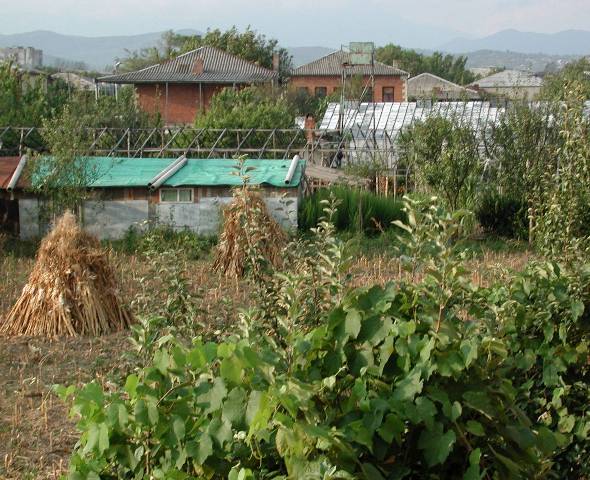
Yesterday, I met a Georgian architect Temur Jordaze who
wanted to know more about architectural lighting. I told him
the little I know and directed him to architects in the
States, particularly the firm of OlsonSundberg in Seattle
who have their own daylight lab which can create the daytime
lighting for any spot on earth. I learned later that he
followed my introduction and journeyed to Seattle. I may
have started something. He may just bring back to Georgia
new ideas in daylight lighting technology to create future
buildings. Information is still the way to the future. When
I ask him, as he is a professor at Tbilisi State Academy of
Fine Arts as I am, “When my classes in the second semester
start?”, he told me, “About February 1st or March
15th.” He said it with a straight face and it was
all that I could do not to laugh. Yet, I learned later that
it was a ridiculous statement and absolutely correct. At
that time, I thanked him and though, “OK, all I need to
teach is a place, students and a time. If the Academy makes
its schedule of opening second semester on the temperature
of winter and has no electricity and therefore no heat, I
will move to a place that has heat and space.” The Academy
did not start classes until March 1st and
therefore I taught all of February at the National State
University, letting my Academy students know where I was
lecturing and allowing them to come. Each class had over
seventy students.
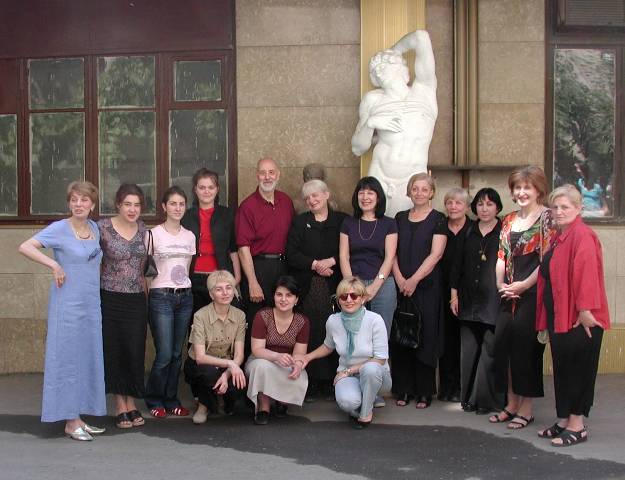
I taught my class on museum studies at the Academy today. We
circle the desks which appeared to have never been moved
from their authoritarian positions facing the front of the
classroom. We build a board of trustees, make policies,
recruit new board members and do other American Museum
Association ideas. What is for me a way of life is all new
to them. The Director of the Art History Department, who was
sitting in, asked, “Do museums that are supported by the
government have this kind of system?” My answer was, “Yes.”
“Do art galleries?” “No,” I said, “businesses do not have to
have American Association of Museum’s standards or
accreditation.” “What is accreditation?” It was at this
point that I knew that some complex ideas had to been
explained after finding any close equivalent in Georgian
life. Our ideas are tied so strongly into American freedom,
democracy and individual rights that it is hard to explain
them here. All decisions for years have come from the top
down, not with the people on the bottom up. The daughter of
a good Georgian friend went to have minor operation. She has
lived in America for her high school years. Now, she is
annoyed that the doctors would not tell her what they were
doing. She told them it was her body. One doctor said, “For
now, it is ours.”
My techniques of teaching have been perfected over the years
by taking time off to learn how to get across material in
short segment (by becoming a disc jockey for a time) and how
to use my voice as an instrument of learning (acting in
plays to learn projection). I use the whole space of the
classroom, an idea that is revolutionary here. I break the
imaginary plane between teacher and student all the time.
For me, using the space that normally causes a separation
between the teacher and the student is a way to identify
with the student and his or her needs. The Georgian system
is to stay in front and tell the students information (which
is out of date by the time they get out of school). Their
job is to memorize, not think. I make them work at thinking
and, eventually, they enjoy learning. Also I use humor to
get across major points. An individual who can laugh is open
to new ideas. I enjoy teaching and these students are so
appreciative.
In any situation that an artist finds himself, he must
look at different ways to see information. A simple question
like “Do you have the keys?” may be the beginning for a new
way of thinking about the events of daily life anywhere.
To Have or Have Not
It all started innocently enough. My wife Anne and I were
leaving our apartment in Tbilisi and she said, “Do you have
the keys?” I was in one of those moods where a simple answer
just is not in my nature and I said, “No, the keys have me.”
That did it. Much of that day, the next and into the week
all that I could think about was all the things in daily
life that “had” me in their grasp. I thought of all that had
gone on since leaving America to come to Georgia as a
Fulbright Scholar.
At one time I did not have a computer to type out my
articles. I had a typewriter who had me. Before that I wrote
out my thoughts longhand (which I do again now when there is
no electricity which is often) and then passed them over to
my secretary who had me until she was finished. Now, it is
email. I check it the morning, the afternoon, the evening
after dinner and, if I get up in the middle of the night, I
check in to my master again. It has me good. Writing letters
seems like something that is in the past. Even then I had to
have a certain pencil or pen. Of course, I do write at times
and then fax the pages to the some unseen source. The fax
has me too.
It is not enough that my computer, fax and email have me.
Now I need a scanner. Of course, without all this, I have
(or it has me) my office away from my home office, the
American Embassy of Georgia. They know me by name. They have
me because they own my time and knowledge when I pass over
some gem that just must be done “now”. Time has me too.
Raphael, my driver in Tbilisi, has me. When his car is in
the repair shop, they have me. The apartment owns me more
than I own the apartment. In America, just ask the bank who
holds the mortgage on our home, having sway over a cut of
the social security check that I now get from the government
since I retired to be free from others “having my time”. The
income tax deadline will pass while we are in Georgia.
Anyone who does not believe that the government does not
“have” us is cheating on their tax returns. Even at this
distance, my dog and cat own me. I get daily reports of my
relatives taking them out when they want to go. Little
things have me too in this modern world. A lock when it will
not open. The bureau door that is jammed and I cannot summon
its services. Electricians and plumbers have me. CNN news on
my laptop controls my first hour of being awake.
In America, it is the telephone. Now don’t start me about
the telephone. Even when I am not there, the answering
machine has a message that I just can’t miss. Those unwanted
calls in the evening that starts with, “Joe, it is wonderful
catching you at home. We have a deal that you just can’t
refuse.” Well, “brother (actually “bother”), you don’t have
me!” I can hang up the phone now as fast as any Western
gunslinger. (In fact, one of the joys of being away in a
foreign land is that you don’t get programmed calls
anymore). In America or when I go the Embassy in Georgia,
the television is something when it is on “has” me. When my
mind is tired, I watch anything, falling asleep to the soft
sounds of murder, love, Chinese news broadcasts (in
Chinese), sports of any kind, commercials, talk shows, “sit
coms”, and cartoons. All of them “have” me for a time. And
then there is the addiction to the Internet! My bed has me a
third of my life. The bathroom has its time too. The craze
for health has me. At least my wife and I do not have each
other. We share each other.
“Who has me now?” I ask some days. Who owns me for this
precious second or minute? The car, the computer, a promise
makes “To have or have not” the question of the day. Some
times during the day, a simple question like “Do you have
the keys to the apartment?” is more complex when you begin
to think about who has what and when. Do I have a name or
does my name own me? It is a puzzlement. Have you ever
answered questions to an insurance form where they want your
medical card number and the company, your social security
number, your telephone number and your address before they
ever try to learn who you are or why you want to see the
doctor? I have learned the secret though. It is to “unhave”.
For years, I collected works of art until I began to realize
some of them “own“ me. To unhave frees us all. In Tbilisi,
Georgia, I have less things and more time to find out who I
am.
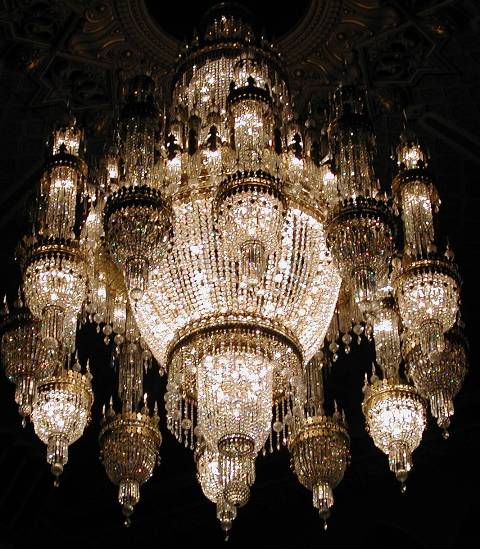

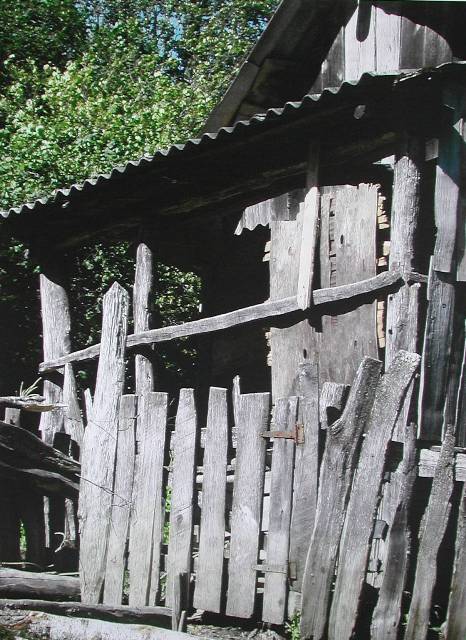
Another element that artist needs is more time, therefore
processes that extend the psychological moment is critical
to exploring the wonders and mysteries of everyday living.
Extend the Moment. Live Longer.
Driving down Rusteveli Avenue early in the
morning, before going to class at the Academy, watching the
cars that pass in no seeming order, thoughts raced around
the speedway of my mind. There is so much to do and so
little time to do it all. And “all” is what most of us want
to do each day. We forget to leave a little for the next
day. We have forgotten Hewingway’s lesson when he left a
story incomplete in a day’s writing so that the next day he
had someplace to start the process of creating a new day’s
work.
Now on this street in a strange land, Georgia, I
determined that I would see, record and marvel at this
special sight. There had been so many days when that same
resolution had been made and I was surprised when I realized
that I had missed the whole wondrous scene, thinking about a
telephone call which had to be made, or a lesson to be
planned, or a chore that just had to be completed in the
next fraction of a second. This time I was determined that I
would see and enjoy.
Going down a hill, I received glimpses of the
smooth waters of the winding dark river through the trees.
Then the scene opened as I got closer. Finally, it spread
before me: a simple scene of blue sky, glass-like river
water that so many have struggled to control, the
August-filled trees and bushes, and another hill to climb in
this Russian-made chariot. The moment is held as long as it
can be held. It is extended in time by the joy of the scene
with Georgian churches perched on the edge of the hills..
The serene horizontal of the far bank, the water that dances
with light and soft color fills my being. I have done it. I
have captured the moment. The fast pace of modern living has
not won the day. Light, color, water, sky, green-green and
rocks are all that exist.
It is the same struggle that was depicted in a
recent movie, “Star Trek: Insurrection”, which we saw and
enjoyed in Russian. A major theme centered on a battle
against those who would cast out innocence, art and
fulfilled-living and those who held these attributes close
to the heart. The 300-year-old beauty showed Captain Pecard
how to extend the moment by blowing pollen from a flower.
The star-like golden specks gleaned in the sun’s light in
slow movement. Pecard, a man of the future (our future of
technology and swift action) was forced to slow his glaze to
a shuffled pace.
The river is before me again. I have to rush to
the American Embassy to get something reproduced quickly.
That is what Embassy does. It helps Fulbright Scholars. It
is not Kinkos, which was created to speed up our office
work, but they are a help in Georgia.. Again, it is a
struggle to forget my hectic job for a moment. I have to
say, “Work does not exist. Work does not exist.” And for the
moment coming over the crest of another hill, diving into
the green blue of the river and the park lined with men
waiting for work, and the magnificent Tbilisi sky, work
disappears. Isn’t that what all of us wish to do? To live
longer! Not in years, but in the extension of the moment. It
is not the length of our lives that counts but how we use
each precious moment and extend those moments. Tbilisi,
Georgia is a wonderful place for extended moments. Modern
life does not allow long periods of slow contemplation, but
when we can have them they are the joy of living. We can
truly see, hear, feel, enjoy and learn.
It reminds me of the story of the beggar in an
India market. He is starving. All day, day after day, he
begs for money. A kindly merchant watches this drama for a
week. Finally, he gives the beggar money and tells him to
buy himself some food so that his life would be prolonged.
The beggar thanks the merchant and takes half the money and
boys food. With the other half, he buys a flower. The
merchant is angry. He has not given the man money to throw
away.
“Why have you bought that flower?” asks the irate merchant.
The humble beggar answers, “Half your money will
keep me alive for half a day. Holding the flower in my hand
while I eat makes life worth living”.
Tbilisi, Georgia, on this special day, is this
beggar’s flower.

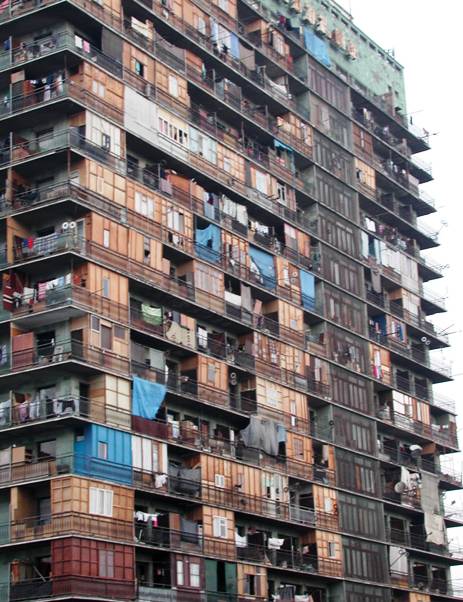
Tbilisi, Georgia 2
I sit in the twenty foot by fifteen foot living room,
looking up to the extra high ceilings and a crystal
chandelier. The doors are four inches thick and hold out the
sound between the labyrinths of rooms. There are wood inlaid
floors, a refrigerator from the 1920s which hold the
Georgian beer which I love so much, a washing machine is
rattling its age from the 18th century (it seems)
and books, books, books, antiques, antiques, antiques,
dating back to the Ice Age. Everything is lovely but it is
antique. I took down all the dark paintings, in style as
well as color, and put up my own paintings. All my color
seems strangely out of place. As I have said before, black
is the dominant color in Georgia. Well, that’s us, strangely
out of place and time.
I called my daughter, Samantha, today and told her, “I love
you,” before she had a chance to speak. She laughed, because
she says that I am weird, and said, “I love you too, Dad.”
Funny but I needed that feeling from home. Being away as a
Fulbright Scholar, you don’t need material things (you can’t
get them anyway) but you do need to know that some few
special people love you as you love them. The Georgians are
right in the supra. Family should be toasted at every meal
because it is the life blood of this society, or any
society.
What I saw in Kutaisi, in Kharaguali, at the Black Sea, here
in Tbilisi, at Rustavi, and later at Telavi when we went to
a dinner and had a supra was the possible death of the
supra. It was created for two reasons: to celebrate the most
important things in Georgian life and to keep the creative
minds of the participants alive as their bodies were
oppressed by outside forces. What is happening is an
internal stagnation of the tradition. It should have some
codification at the beginning and the end. The beginning of
the supra should be honoring guest, country and family, the
three staples of Georgian tradition; the end should be to
honor the tamada, since this is a demanding and taxing job,
but the middle should be free to celebrate ideas, to build
upon themes, to let the creative minds of the participants
fly and soar. That is how it began. That is how it should
grow. That is how it will survive as a vibrant part of an
emerging democracy. It should be a time to celebrate the
poetry of ideas and feelings. It should live and grow.
Things which do not do grow, die!
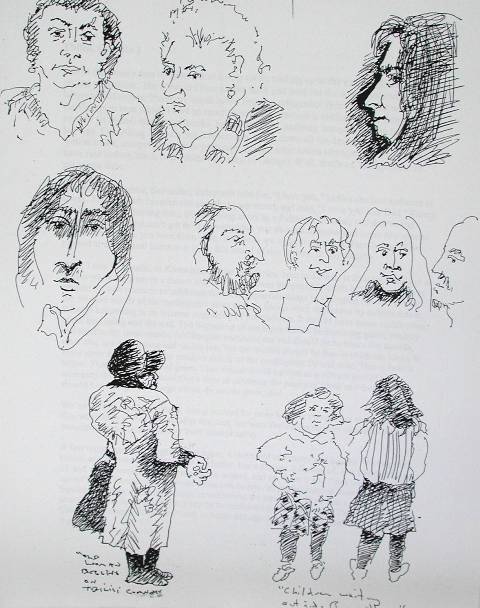
We have been emailing friends, being starved for news
because there is not much and rumor fills what there is. For
a while after the alert, we were feeling the tension of
threats from local terrorists but our routine is now built
around safety.
A few nights ago, we stepped into it again, a rare night of
wonder and beauty. We buy our tickets and are told that this
time it is a ballet. For a change, it is, sort of, and a
pageant, sort of, and the presentation of a dance, music
school, sort of. What it was “was wonderful”! The age of the
performers was between seven and twenty, all professional in
their parts, all two hundred and fifty of them on stage,
sometimes at the same time. How can a society so
knowledgeable in the performing arts be so backward in the
visual arts? This was the Batumi Children’s Concert.
“Children” only in name and age. In performance, they were
as good as it gets.
I went to teach my class in 20th century
criticism with Ketevan Kintsurashvili but it was delayed
because the students were out in mass painting a group
action mural and listening to a hired rock band. Anne stayed
behind with Nino, another professor in the Art History
Department, to watch how Georgians make their delicious
bread. She is fascinated. There is a large ceramic drum-like
kiln on a dirt floor. It is heated to blazing hot, then the
dough is slapped on the side and the bread is baked. It is
then scrapped off like our pizza except it is horizontal. It
is again, using that overused word, wonderful!
Outside the Opera House, I draw and observe. Only the young
wear color and that is just for accent to the black or red.
Tight pants and shawls are everywhere, and one little girl
is all in purple which stands out against the blacks, grays
and browns. Rustelili Avenue is the main six lane street
through Tbilisi and is always busy. You do not cross because
everyone drives too fast and never stops for anything,
especially red lights. So you go under the streets, passing
the beggars, small shops and strolling musicians. In the
Opera House, a man comes in front of the curtain and tells
the children the story of “Swan Lake”. I cannot understand a
word he says but the tone is storytelling and the way the
children listen I know that it is a story.
Swan Lake is a full adult ballet, danced by professionals to
a full symphony orchestra. It is not a children’s
performance although the house is packed with mothers,
fathers and children. It is a noon Sunday performance. The
dancers move with extreme talent. The children can come free
if they sit on a parent’s lap (normally the mother’s) and
all this for 10 lari ($5.00 USD).
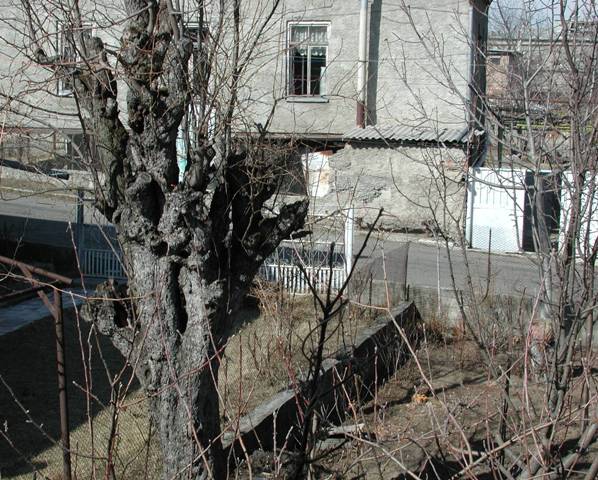
The Opera House is decorated in the old, grand style with
exquisite sets, a large stage, magnificent chandelier and
side lamps in the antique fashion of the late 19th
century. The house lights dim, the second act begins where
the first act ended with the young hunter who has fallen in
love with the graceful swan. Twenty four other swan
ballerinas dance as one. The black swan/wizard makes his
ominous appearance. Later, under the spell of this black
wizard, the white swan turns black. They dance together. The
young man gives his heart (flowers) to the prima ballerina
(the black swan now) and she spurns him, leaving with the
magical male black swan (now a dark human figure) and the
second act ends at court with the heartbroken young prince.
In the last act, the dark sorcerer and the young man fight
to the death. The young man wins. He and the white swan are
joined forever and ride into the heavens on a chariot.
Curtain! Marvelous, even with a story that is an excuse for
great dancing. Flowers, which are in abundance on every
corner of Tbilisi for a reasonable expense, are presented
from the audience to the prima ballerina, the lead male
dancer, and some selected other ballerinas.
That night, I work on a new series of paintings called
“Quarter Turn”. The idea happens as I look again at Monet’s
Haystack series. All the compositions are the same. Only the
light and color changes. I ask myself, “What would happen if
I painted the same composition and made a quarter turn of
the color study so that the order of the colors would change
in terms of the spaces they inhabit?” What happens to my
pleasure and surprise is that the paintings change in
character although the composition stays the same and the
colors are the same but in a new order. Ideas have a life
cycle like people and organizations: birth, life and death.
This idea is in its infancy
I decided to go to the Academy and draw with the students.
They have a model and I need the practice. What I did not
know until later was this is again revolutionary. Teachers
do not work alongside students. One young girl meets me and
shows me where I am to work. It is a studio in the 19th
century style (I am saying that often but it is true). It is
a large room with a skylight, dirty floors (I will never
bring my jacket or red bag again), high Gothic arched
ceilings. For the painters in the class, their palettes are
arranged in a Renaissance style from white to yellow to red
to…etc. until black. The painting is also locked into the
last century. The drawing is Renaissance. Well done, but it
is Renaissance and classical (not a bad tradition if the
students are also allowed to do 20th century
ideas). It is interesting to see how the students react to
my drawing style. I call it “cluster thinking”. They have
been taught to build the figure from proportions and basic
forms. For me, all this is in my head and not on the page. I
try to find the clusters that make up the heart of the
experience of seeing. It is how the human body begins as a
cluster of lines and forms. All else can be drawn around the
key cluster to the vision. You have to have Renaissance
proportions but it is internal and not on the page. You know
this before you look for the prime cluster.
As I began to draw, I noticed that nothing at the Academy
starts when the schedule (if there is such a thing in
Georgia) states. I know that I have plenty of time to draw
and write before even seeing the professor for the class. As
I came in I noticed professors standing around outside,
smoking and talking until 10:30 when a class was to begin at
9:30.
It is understandable. No one is paid much for their efforts.
A professor makes between 15 and 20 lari a month, no salary
to live on, no salary to rush to class to teach. The
professor’s attitude is passed on down to the students. Only
a few come to class on time except me. I am stupid enough to
think that art is its own reward.
In front of me is a model stand, an old mattress, torn
clothe, a kind of shawl for an added touch of color with a
piece of silk. I hope that today’s model is young. Yesterday
the models were ancient and huge. The model comes in, a
young lady in late twenties, and she puts a clean sheet
which she has brought over the model stand. I think, “I
wonder how much it would take to scrub these floors. I guess
scrubbing is out of the economic question”. It is cold and
the model plugs in her electric heater, after she repairs
the plug. Nothing is simple here. My heart goes out to this
model who poses in her panties and for Georgia.
Mzia came to clean today and help Anne with her Georgian
phrases. They have struck up a good friendship. Later, the
landlady came with the men to install a gas heater which
will vent to the outside. They drill through one of the back
walls. As they finish, we are told that it will warm the
whole apartment It barely heats the one small room where it
is placed and we close off two rooms to the cold to take the
chill off the rest of area. We will use electric heaters in
the rooms where we spend the most time, the bedroom and the
computer room, and we will survive the winter in better
shape than most Georgians. We also keep a kerosene heater as
backup for those days when there is no gas or electricity.
Tonight we attend the performance of Jesus Christ Superstar
by a visiting Russian company. We know it so well that we
are looking forward to hearing it in Russian. In fact, we
saw Jurasic Park 3 in Russian. How much translation does
screaming take? Again, we were surprised when the company
did the whole performance in English. So far, nothing that
we have attended is what we thought it might be but the
quality of performance is there. They did the whole musical,
two standing encores and then came back and did seven more
encores as a tribute to the history of rock and roll. People
were standing in the aisles, on the side of the theater, and
all those plus the seated audience stood as one and cheered.
It was that good. We have seen some magnificent performances
on Broadway but this production rates with the best. These
performers could hold their own and make a living from their
profession anywhere.
My pattern of getting up in the middle of the night and
staying up painting will have to change. I need to stay in
bed and try to get back to sleep but it is hard. My mind
keeps racing to all the projects that I am juggling:
painting, classes, exhibitions, fund raising, consulting,
etc. I cannot complain how it has affected my painting. I am
doing the best work of my life. Why it is that getting away
from America brings out the best in me? Maybe it is
perspective. I get to look objectively at my ideas, my work
and my life. Whatever it is, the painting is as good as I
can be at this point in time, pushing seventy from the lower
end.
I have begun to think that “Quarter Turn” is not just a
physical thing for the painting, an idea or an action, but
it is more like the changing of seasons. Winter, spring,
summer and fall are a quarter turn therefore I will instruct
the American Embassy to make a turn of my painting every
three months. This idea of seasons changing the colors again
goes back to the Impressionists. I have been thinking a
great deal about Monet and his experiments with color and
light. I do not wish to do Impressionism but there is a germ
of an idea working at the corners of my mind that has real
meaning and merit. It is beginning to emerge that may cause
a whole new direction in my work. It is always a troubling
time when I lose sleep but also it keeps me young inside and
is exciting.
Tbilisi 3
Our record is still in place. We still have not gone to one
performance where it happens as the program reads or was
something other than what we were told.
I have a good session with the gallery directors. It is an
open discussion of hopes, visions, and concerns for their
businesses. We discuss the state of the visual arts in
Georgia. The only negative that I get back is, “Yes, you can
do that in America but this is Georgia. We cannot find money
to do what is needed.” I agree that I do not know Georgia
yet as the people in that room do therefore they have to
come up with long term answers to their questions. My
question to them is, “If you try something new, could you be
any worse than you are now?” I know that two of the
directors who did not speak up have gotten grants and did
some new things in Georgia. After class I ask them to report
on their projects the next session. Until then, I promise to
visit all the establishment of those present and discuss
their problems on their home territory. We will all meet
again in a month and begin to collectively discuss
solutions. While we are engrossed in this discussion,
protesters march on Parliament and Rustevili Avenue is
closed to traffic. Also they lock the doors of the museum
where we are having our meeting. Thousands are marching. It
is the sixties in the States for me all over again. When the
session is over, we are lead by a museum guard through the
labyrinth of passageways under the museum and out a side
door.
The next day the protesters are still marching and
assembling in front of Parliament. This will continue until
Parliament breaks up its talks this weekend. I call the
Embassy to see if I have class at the Academy on art
criticism and am told it was safe. The marchers are
peaceful. But I remember Chicago’s marches and what started
as peaceful demonstrations became violent. If you are
assembling a large mound of hay, all it takes is one match
to set it aflame. We cancel my class and our plans to go out
to dinner in that area.
One thing is sure in my mind after working with the museum
professionals and the owners of art galleries: arts
management and knowledge about American art are dramatically
needed in Georgia.
Tonight, in what the Georgians call “old town”, we attend
two art openings in the same building, Caravan-sarai Gallery
in the National Historical Museum. By far, the exhibition by
Georgi Alexi-Meskhishvili is the strongest contemporary art
that I have seen. He is now teaching at my alma mater,
Dartmouth College, but for years he was the senior set
designer for the Opera House and the National Theater. What
shows so strongly is his sense of play with images, words
and surface. Another art exhibition, by an artist named
Levon, shows art work from the 1980s that had been banned by
the Communists. It also is strong in content and execution.
Caravan-sarai is a wonderful space on the second floor to
show art. I will look into having it for my December
exhibition.
I sit now away from the crowd, feeling the effects of two
days with a cold. I am ready for a few days of rest. We will
go home early tonight but I am also glad I came because the
art is stimulating. It is as good as anything I have found,
powerful and playful at the same time. It is refreshing to
see this quality of work in contemporary art but it is also
too bad that the best Georgian artists have to go abroad to
find a market for their creativity.
We shop at our local market and now we are “regulars”. Again
I need rest. This cold has me extra tired therefore I nap
for an hour. When I awake there is no electricity. This is
the first time for us in Tbilsi (in Kutaisi it was a daily
outage). Our driver, Raphael, has gone three days without
lights and heat and his son, Michael, could not study his
lessons in Russian, English and Georgian. It gets old very
fast to be without electricity all the time. People have
learned to put up with it for years. I can understand the
demonstrations now by the students and their march on
Parliament. Candle light is romantic only when it is a
choice.
I talk to Anne about how, with all this painting everyday, I
am back to the place in my life where I wake at night,
visualize a whole or part section of a painting, and paint
it in my mind, the colors materializing as I put them in
place. There is a study of a woman who has been tested to
hold 10,000 bits of visual information in her mind and can
recall any segment. I can walk through a gallery quickly,
almost running by the paintings, and later tell you all
about the colors, lines, brushstrokes, forms and content of
the works. It takes me about two walk-throughs to collect
this visual information. Sometimes years later I can walk
again through that same exhibit in my mind’s eye and tell
you where each painting was placed and how it was painted. I
have never thought much about this ability because it has
always been a part of my sight but now I understand that it
is a gift. School never rewarded visualization except in art
so I learned to play the word games for success but my
strength has been my visualization. Just as I said the word,
“visualization”, to Anne, the lights came on and we get up.
I help the American Embassy interview five women for a
Hubert Humphrey Fellowship, 30 minutes each. Two are very
strong, one came close but did not have the advance degree
needed to go with her stated purpose for applying, and two
are too young to really qualify. We will send one of their
names to Washington for the final decision. I am impressed
with the strength of all their resolve that Georgia will
change for the better if they have any say in the process.
No men apply.
We go to the Free Theater, which is not free in admissions
cost, to see Medea. A haunting classic beauty sat in front
of us. There can be no place on the face of the earth with
as many beautiful women in the Greek statue classical sense.
The men are good looking but many of the women are
spectacular. At every event, I marvel at their features.
Matisse and Picasso would have models forever from this
Georgian society. I know that I have remarked on this fact
before but it still surprises me walking in the street or
going to a theater performance.
From the womb of the Gods (the eye of an ancient sculpture)
comes Medea with a dancer of the fates interweaving her
fatal despair in a kind of dance macabre after she murders
her children (who came from her womb). The many faces
(masks) of our lives are worn by the actors, just as the
three fates (the cruel masked sisters who spin our destiny
and cut the thread of our lives). The four masks are worn
first by the fates, then Medea, then the dancers, then put
away. The dancer of destiny and Medea look into a momentary
tableau. An aged masked figure appears, carried by the youth
of the gods. His mask is forged in the fires of Vulcan and
Medea becomes the temptress, the shaper of death and a
faithful, adoring lover.
The old man takes off his mask and finds his love, Medea.
All that is left for Medea is the favors of sex (which when
kissing stings her lips). The old man leaves, receiving the
favor of a kiss, carried by youth to die. Then the youths
come again, exchanging symbols of Medea’s crime against her
children and begin to rebuild the image of the Greek gods.
Her husband returns from the wars and finds out her bloody
deed. They live together in an embrace of peace in a sea of
madness and the broken pieces of the god’s image.
After her husband leaves again, all that is left is a mask
existence for Medea. Her mother returns from the grave to
torment her with the punishment of Zeus. The dancer of
destiny returns with the four masks. After removing the last
mask, we see a fifth painted on the dancer’s face. She
dances with Medea and all the pieces of the broken god are
assembled. Medea’s time is up. The fabric of her life is
broken like the statue and she dies under the rubble of the
god’s statue crumbling upon her.
The lead woman who plays Medea is magnificent, a strong
character for a strong part. Flowers are thrown on the stage
as she takes her last bow, flowers are handed to her by the
audience, flowers are everywhere. For us, it is another
simple evening in Tbilisi, Georgia.
I have found what I sought, a tool to teach arts management
to students and professionals. It has been in front of me
all the time, the supra. The tamada is the CEO or director,
the others are players. Today I use the supra for them to
begin to think of “how to find grant funds”. The idea of
sweat labor to balance a request for funds from a foundation
is totally foreign to the student’s thinking. The Communists
and their parents gave but never asked what was needed. To
analyze strengths and weaknesses and then to pursue only the
strength is again a new concept. Getting money through the
grant process is second nature to me. I do not need to think
about it. I just do it. I start with what is needed, work up
the budget and then proceed to the narrative. Teaching these
concepts is so hard because asking for funds is new and I
work through an interpreter. The supra, at least, is
something they know. What they are not used to is taking one
system from one source and using it in another context.
After class, I stop down in the pits of the Academy to see
my carpenter. He is finishing the sanding of the framework
for my painting that I sold to the American Embassy. He is
proud of his job and I compliment him with a thumps-up sign.
Today is the day when I move the paper painting onto the
framework. It is exciting to think that finally the time has
come but also a little frightening, two months work which
can be lost if the glue is not right, the workers cannot
communicate or my planning is flawed. I have gone over the
process in my mind again and again. I know the first step,
the next and the final finishing with the hot iron to smooth
the surface and make the glue permanent as a bond. I am
working with help who do not understand my language or this
concept of art. I work with glue that comes from Turkey
which I never used before this time. I did do a small
example on a board but this is a six foot by six foot
painting on paper. I have a momentary panic attack when a
thought comes into my mind, “What if he flipped the template
and the shaped painting does not fit?” No, I cannot think
defeat. This can be glorious or it can be like many creative
attempts in Georgia, a bust. If I fail today, I have a
backup plan to use the framework for a new painting. I will
not fail today.
We struggled but it is finished and it looks great. The
American Embassy will be pleased because I am pleased (and I
am a harder critic of my work than any patron). Even my
co-workers admired it. Anne thinks that my painting now is
my best (and she has learned to be a harsh critic). Tomorrow
we will take it on top of Raphael’s car to the American
Embassy of Georgia for its final placement on the wall over
the fireplace in the master ballroom.
I cannot think about that now. Tomorrow I have three
lectures, two in Rustavi, a town near Tbilisi, and one at
the Tbilisi State Academy of Fine Arts, my host institution.
Today, I gave the “American Education” lecture to the
National State University, stressing the three kinds of
democracy which is the basis of American education: 1)
Thomas Jefferson’s idea of educating the best and the
brightest to lead the nation, 2) a mercantile America where
the government gets funds to aid the people, and 3) Thomas
Paine’s idea of one vote, one person, so that the people can
change leaders who do no serve them well. We play my
information game. The students enjoy it because it brings
home how much they “need information”. I discuss the four
aspects of American education from a leadership perspective.
If the audience knows nothing, tell them. If an audience
knows a little, show them. If an audience knows as much as
you, work alongside of them as a partner in education. If
an audience knows more than you, get out of their way but
find them the resources to accomplish their goals.
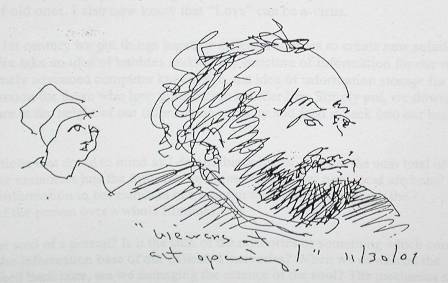
The one thing that is troubling now, living abroad, is
the rise in international terrorism. Everyday is a challenge
for security and well being. This new threat to freedom adds
an additional burden to any Fulbright Scholar. This article
tried to examine this situation.
Living Abroad
in Today’s World
You wake in the morning at six in an apartment in Tbilisi,
Georgia. In your mind, you go over what the day will hold
and what it will not. Before September 11th in
America, it held endless possibilities- walking through the
bizarre to view all the merchandise from around the world,
stopping by the river to view the paintings and objects from
now-open attics, strolling along Rustaveli Avenue (the main
road going through this city of 1.6 million people),
stopping at the US Embassy to check on the week’s schedule,
or just going downstairs to buy bread, cheese, some Coke,
Russian potato salad and bottled water. Now, since the
tragedy, I wake and take things off the list.
If we go to the bizarre with its constant stream of milling,
jostling people, looking for the just the right thing or
some stable that is needed for the day, we take our driver
for communication and protection. We do not stop by the
river to brose the venders’ wares. The bazaar at the river
has been a place where northern Georgian terrorists have
been sighted. Walking the main street in Tbilisi is a
decision that is made with “when” not “if”. We never go
there now in the evening, except when we have tickets for a
performance and our driver, Raphael, takes us and picks us
up directly after the event. Spar of the moment dinners at
some newly-found restaurant, on some street off the beaten
path, is out of the question, except after we check it out
during the day and plan the time and the departure.
Each time we stop at the US Embassy, new construction is
going on. Now it is large concrete barriers to replace and
partner with the already large concrete barriers to stop
cars ramming through and attacking this special place for
Americans. Just after the September 11th
declaration of war, all Americans were gathered and told
that they had been “possibly” singled out in Tbilisi for
kidnapping (therefore take “extra precautions”). We were
told to watch if anyone was following us. “Do not take
public transportation if possible. And when driving, leave
enough room between you and the car in front of you if you
stop”. That is so you can escape. One American asked, “How
can you tell if a suspicious character is following you in a
country where almost no American speaks the language,
everyone can look “suspicious” and people follow you all the
time “just to hear English” and “practice their language
skills”? Nothing has happened, although some of the Embassy
staff had been told by the local authorities that they had
been targeted for kidnapping, but the threat of something
happening makes you look over your shoulder when walking the
streets.
Our apartment on the second floor has two steel doors, with
a heavy forged slide lock on the inside door, and bars on
the windows (left over from Communist times). To get to our
door, we walk up two flights of dark stairs. In the evening,
when we go down to buy groceries at our friendly markets and
return home, the first action when entering the building is
to look behind the entrance door to a dark corner where no
one is hiding but the idea has been planted. One advantage
in any city, even when the times are not as tense, is that
you are finally known by your neighbors, your shop workers,
our man selling fruits and vegetables, and the other tenants
to the apartment house. The people around you begin to look
after your well being. You begin to smile at others who also
look over their shoulder because this has been a way of life
for Georgians for a much longer time than Americans living
abroad have experienced it. You find that how they react
conditions your actions.
I was teaching at a state museum to gallery owners and
non-governmental agencies when the great October march on
the Parliament Building came. The museum was closed with us
in it. Most Georgians stayed away from the marchers and
that area (most of my students did not), but after the
second day it became normal to adjust to “no government”
(since members of the Parliament resigned after the
protests). One of my friends in the States asked by email,
“What is it like living abroad now?” I wrote back, “Tense
but normal (and not tense all the time).” The one thing that
is comforting is the knowledge that these are the warmest,
friendliest, most hospitable people in the world. Situations
are situations. There is never a totally safe time in the
modern world. You make decisions based upon your priorities.
One of our priorities is the refusal to live in fear. Tense,
yes, but normal.
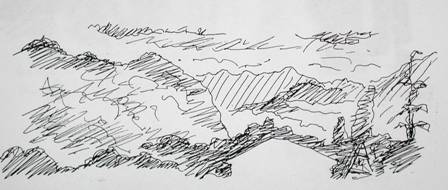
What keeps the mind and spirit alive and well many days
is ideas and images. The Greeks called that combination an
“ideate”. In Georgia, you need all the ideates that you can
create. The Rolling Around Effect examined this phenomena.
The Rolling Around Effect
Did you ever have an idea roll around in your head, bouncing
off the electric connections so that new connections are
created? It happens to me all the time. I get interested in
circles when flying over Arizona on my way to losing my
money in Vegas. The circles are new watering patterns made
by farmers to irrigate their land. The new patterns grace
the landscape as far as the eye can see. Next, the idea of
bubble technology is introduced to my brain computer by
Lucent Technologies where information can be stored and
transmitted by bubbles (just more circles). Next, I am
watching television and listening to the search for answers
for Alzheimer patients, thinking about the circles of
friends and stored information, emotions, memories of
earlier times that makes old age a vintage time in one’s
life. Last, I write almost everyday on this computer,
backing up the information that I create with marked discs
so that I retrieve the data.
Now comes the rolling around effect, the stew that is
produced when all these ideas are kept in the air like
bubbles. I know that the human brain is the most complex
computer in the world. I know that I keep notebooks and
sketchbooks and computer discs to keep ideas afloat for
years which might come together later as a “new idea.”
Now came the great “what if”! What if the computer industry
could put our thoughts on disk, not to place it back in the
computer but to place it back in our brain when we lose
information. I am naive enough to not know the damage that
is done when Alzheimer’s Disease strikes and erases the
computer of our mind. But also, I have watched a Computer
Doctor find 1070 viruses on my computer, clean it out and
reprogram much of the data that was stored, while also
putting up “walls” against a new attack from new viruses or
the reintroduction of old ones. I also now know that “Love”
can be a virus.
What if in the 21st century we put things together different
sources to create new solutions to old problems. We take an
idea of bubbles making the structure of information for our
minds, a dash of extremely advanced computer knowledge, the
idea of information storage for later use, and compassion
for those who lose information in older life. Simply put, we
download data when we are at the height of our information
capacity and feed it back into our brain computer later.
There are questions that come to mind as I dream this
solution. Are we the sum total of our memories or are
memories just the information to interface so that new ideas
are born? If we download the information in our minds at one
point in time, are we lessening the individuality of the
person over a whole lifetime?
What about the soul of a person? Is it the sum of the
memories or something which comes from outside the
information base of our collected memories? When we download
the memories to feed back later, are we damaging the essence
of the soul? The mechanics of the brain with its bubble (or
some other system) technology must have spirit as well as
material substance (memories). How do we insure that the
spirit is retained on our disc of information?
How will all this change education? We cannot separate
information into categories if it is all bouncing bubbles in
a matrix. Will we continue to hear a bell ring in our heads
from our outdated school experience (even if we attended a
school which did not use a bell) to separate math, reading,
art, music, physical education, science, politics, sex,
play, etc.?
Education does not stop in the classroom. We fly over
farmland, watch television, play with grandchildren, kiss a
loved one, and gather memories. I would welcome a backup
system for my life experiences. Maybe in the 21st century we
will be able to download, store and retrieve our minds.
Maybe Alzheimer’s Disease is a complex or simple
human-computer problem. I hope that I am behind the times
and others have thought of this already that have the time
and knowledge for a solution!

Tbilisi 4
I go to my normal class to teach with Ketevan
Kintsurashvili, my co-teacher in art criticism at the
Academy. Nino, another professor in the department, says
that she would like to participate lecturing when we discuss
Brancusi. I have prepared about half an hour of discussion
on how this Rumanian transformed Paris and the art world
with his seemingly simple forms. I have reviewed two work
that are at the Hirshhorn Scupture Garden in Washington, DC.
I though that this would be an easy day for a change since I
am not center stage. I am sharing our eight students with
two other professors. When I walk up the grand staircase
with the two plaster Greek statues on the first landing, I
am met by one of the eight who say that we were in the great
hall, where all the historical paintings hang like reminders
that this Academy is eighty years old and has never grown
up. I use the great hall on Saturday because of the size of
my architecture class. When the crowd starts to come in, I
know this would be no normal class. That day, I lecture on
Brancusi, his influence on 20th century art, his
ideas in sculpture with two examples from the Hirschhorn
Museum, to over 350 in attendance, including the Rumanian
Ambassador and his entourage. The event is sponsored by the
Academy and the Rumanian Embassy. I am prepared to speak all
the time in Georgia because you just never know. I had seen
the poster announcing this event but it was all in Georgian
and I did not recognize my name as a major speaker. In
brief, I wing it with my ability to talk and draw. It must
have been successful because Anne and I are invited to a
limited dinner given by the Ambassador and the Rector, where
Ketevan, Nino and I are celebrated. It just is an example of
what life is like for a Fulbright Scholar in Georgia. You
just never know what is around the next corner.
Days and weeks are speeding by. Already it is December and
my exhibition opens in twenty more days. Yesterday, I found
a printer at a reasonable price (after two outlandish bids
on the work where I was doing all the design work). I guess
that the printers make their profit on their design time
while I was trying to cut that out as a cost. I want a
brochure of twenty pages but at bids of $800 and $720 it is
out of my budget. Now, for a poster and a smaller brochure
it is $260.00 USD, a respectable bid.
An American Supra, the title of my exhibition, opens to over
300 viewers. Some of my artists friends from Kutaisi come
and many of my students at the Academy, plus a few
professors. Afterwards, taking two bottles of wine with us,
we go to Loretta’s studio on the tenth floor of a concrete
disaster built by the Soviets. No electricity so the
elevator is not functioning. We eat fruit, some cakes and
drank wine, relive our time together painting and waiting to
paint in Kutaisi, and light a fire in Loretta’s new
fireplace. All of us escape coughing when the smoke backs up
but a good time is had by all the artists together again. We
talk of a spring exhibition called “Joe and Friends”.
It seems strange to get up in the middle of the night and
not have painting to do. I must rest my wrist from the wear
and tear of painting six to eight hours every day. It has
taken its toil. Plus I am preparing for other jobs that must
be done. The painting has been all-consuming. It has been my
work, my relaxation, my passion for the last three months.
It is strange not having it to do but that too is part of
the process. Even muscles need a rest before they work
again.
From the Georgian Arts and Cultural Center, I get an urgent
telephone call from Maka Dvalishvili, the Director of the
cultural center, that they finally have electricity so they
are going ahead with their Christmas sale. Today, a Friday,
they are printing the invitations for the Sunday opening to
sell museum reproductions which has taken three years to
assemble and create. She is almost in tears that they have
electricity at last. I could not live with this situation
for years as she has. You plan something special for your
museum and your country, you secure funding from Phillip
Morris Company, you select the objects to be reproduced,
have them made to specifications, and then be held up
because the government will not pay the electrical bill for
the National State Museum, where the Arts and Cultural
Center is located. Justice in Georgia is certainly blind.
The pattern continues. I wake at 3:00 a.m., work on the
computer until 4:00 a.m., go back to sleep, wake at 6:00
a.m. to return to the computer, and finally go to the studio
to work on the painting. This morning it is the text from
archeology digs waiting that Maka has sent for editing from
Georgian English to English English. It is more of a
challenge than I expected but I have given Maka my word to
help and I will. I thought that it would be an editing job
but it turns out to be a rewriting job. I complete it and
Maka has her opening on Sunday for museum reproductions. She
asks me to give a public speech. I will work on my
exhibition until 3:30 and leave early to make her event by
4:00 p.m. Nothing starts on time in Georgia so I have some
leeway. Of course, in this case, it did start on time. Just
as I have things figured out, someone changes the rules but
I come to the opening in the middle, give my speech about
the importance of museums owning archeological finds after a
period of research by the academic community. It is more of
a political speech than about art. It targets the members of
the Parliament who are in attendance and trying to create a
law saying that the individual owns national treasures
rather than the national museum and the people of Georgia.
When Raphael was driving by the river the other sunny day,
he stopped the car and asked, “Do I stop or go?” I turned
and the light was red and green. We watched it change once
to yellow and then again to red and green. Cautiously,
Raphael drove on but it is a wonderful symbol of Georgia.
Stop and go. Make up your own mind; move at your own risk;
and never take anything for granted.
The day has finally come. I go to hang the exhibition. All
is ready. There are some unknowns, like how can you drive
small nails into the concrete, but most variables have been
thought out, a floor plan for hanging has been drawn and as
much as possible all is ready. I am a “control freak” when
it comes to my exhibitions. Even my own painting is put
through an inspection before it is shown to the public. I go
over each inch of the work with a magnifying glass, looking
for small things that need corrected. It has always been
this way. Sitting at a table for a meal, I find that I begin
to arrange the knife, fork, spoon, etc. and the spaces
between each object.
I have been reading “The Horse’s Mouth” for the umteeth
time. The book is literally falling apart so I leave pages
of it all over the house, in the Embassy, at restaurants,
everywhere. Gulley Jimson, the artist in the story, would
have approved of the book’s demise. I appreciate his
descriptions of the artist’s vision and I love his passion
for seeing. Joyce Cary understands the mind of the painter.
Gulley is an artist in his sixties. I am an artist in my
sixties. He lives his life as a free spirit. I live my life…
The parallel are striking and I can look through Gulley’s
eyes as if they were my own.
As I sit here writing, I find that our decision to fly home
for Christmas is not just right but critical. When I went
recently with Nata, the Cultural Affairs Assistant at the
Embassy, to view the copy for the exhibition brochure, she
went one way and I returned to the apartment. She found me a
taxi, told the driver where I lived and set me on my way.
Halfway I realized that we were going in the wrong
direction. There had been so much talk about kidnapping of
Americans that I had to calm my nerves before gesturing to
the driver, “The other way.” I had been to Rustavi, about
twenty miles from town, and that is where we were headed. At
another time in my life and another time in history, I would
have let the situation continue to see if a new adventure
could be found but now I wanted to be where I felt safe. A
German diplomat had been murdered with a rock two nights
before as he got into his elevator to go to his apartment. I
knew one word for direction, “Adjara Hotel”, which was
across from our apartment. With gestures and that one word,
the taxi was turned around and we drove home. He charged me
for his mistake as I got out of the taxi but I did not care.
This is typical of life in Georgia at this moment in time,
for a foreigner in a land away from America after September
11th. All you want is routine. No surprises. All you want in
Georgia is safe passage from point A to point B.
Today is finishing day at Caravan-sarai Gallery. We take the
painting from the Embassy ballroom as the center piece for
the exhibition plus all the work from the apartment. Anne
and I finish what a team of us started two days before. It
takes three and half hours to complete the hanging, get up
the signage and make last minute adjustments. We have many
visitors as we work. It is freezing and the cold finally
gets to me. The walls are at least five feet thick and
retain the night’s chill for the day. On the way home, we
stop again at the Embassy to get warm and to use clean
bathrooms. The toilets at the museum are holes in the floor
and dirty.
The opening is a normal one for Georgia: a large crowd,
interested and perceptive. I have seven to ten interviews
for television, radio and newspaper, sign over one hundred
signatures on my brochure, and talk to individuals who want
to know what this all means. The idea of “Joe and Friends”
gets a push toward reality as Nino, the art critic, decides
that she will curate it. She decides to ask all the artists
who know me from around Georgia to exhibit with me. I am
honored that they care but so tired from the preparation
that it is hard to really enjoy the event. I hired Raphael
and two of his musician friends to play gypsy, Georgian,
Russian, jazz and show tunes. I do not even have a moment to
listen.
Was the exhibition as good as I want it? Yes. Could some
more detail make it better? Yes. But this is Georgia and
nothing comes off totally as it is envisioned. That is the
present tragedy of this country. You cannot plan ahead and
yet you must try. I had drawn the floor plan, selected the
placement of every work, devised a system of hanging panels
between pillars from wires (which Raphael and I bought at
the bazaar), conceived of how the individual pieces could be
hung so that taking it down when I am gone in America would
be simple, and wrote all the copy, having it translated and
the placement on the wall. With all this planning, there
still are adjustments but I did get it hung in two days,
which I was told was impossible, and had a successful
opening from a personal as well as a professional point of
view.
My Georgian artist friends are surprised at my planning.
Planning is not an art that is practiced because of the
frustrations when the event is ruled by factors beyond an
individual’s control. I understand the frustration murdering
initiative but I will never accept it as a way of life.
There is always a way. Contemporary Georgian life is closer
to the existentialist way of living that I once professed in
my youth. Living in the moment is still a glorious way to
savor each segment of living, but I now also believe that
luck comes to those who are prepared. It is my tradition to
plan. From a free society comes hope. In Georgia, tradition
is the one thing that has held this society together as it
was attacked from all sides. Georgia stayed Georgian through
its holding onto traditions. Now that the attacks are not
here, traditions must grow or die. That is why I called the
exhibition “An American Supra”. The supra is a ritual for
celebrating all that is enriching in life and all that
should constantly be held close: freedom, country,
childhood, mountains, heroes, the future, play, love, color
and form, those who have died, icons, family, and being
truly alive.
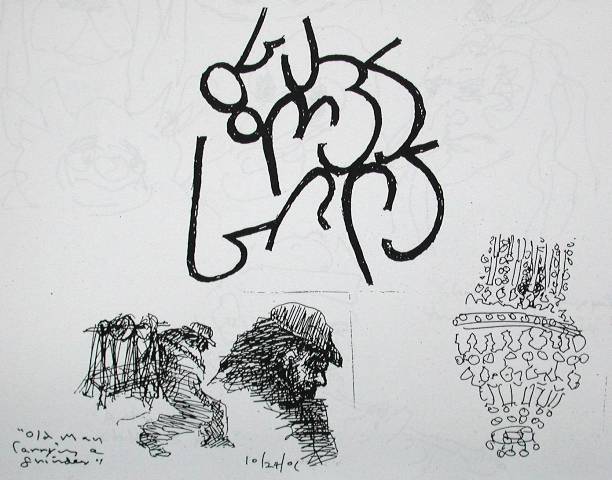
December: Letter from Tbilisi
Letter from Tbilisi: As the Christmas holidays approach,
thoughts go to old friends in America and new places, people
and ideas which have been given us in Georgia- mostly good,
some not. One afternoon at the Black Sea when we were
looking for the perfect snack, a vendor came around with
ears of corn. It was so fresh, tasteful and delicious that I
wondered why it had always been presented to me only with a
full meal.
Once in Kharagauli, I saw that there was water leaking from
under the sink. I looked. There was a bucket to catch the
drainage. Americans take so many things for granted: like
plumbing, electricity and water. In Georgia none of these
things can be assumed. In fact, the opposite is true. I
write this in the middle of the night because this is the
season of “black outs”, loss of electricity and no tap water
all over Georgia.
I feel during the last few months that I have stepped into
the 19th century. The impression started when we
walked into our apartment in Tbilisi that first night. I
could see Renior or Monet living here in the mid 1860’s.
When I worked with artists in Kutaisi in September, we went
on outings like the Impressionists. Reality has changed
since then (although it is refreshing to step back in time).
It is no longer only that which is outside the eye but also
what we know, what we dream and what we imagine. A Georgian
artist told me that this kind of thinking is called
“foreign-born” and “liberal”. Georgia at this time in its
history works by “hurry up and wait”. The dominate color in
dress and life is black.
One of the first things that I, as a man, had to learn is
the rules of the Supra, the traditional men’s toasting
ritual. It happens almost at all times when Georgians gather
to eat and drink. There is a pattern controlled by the
“tamada”, a wise and flexible leader who runs the
celebration dinner like a conductor of a great symphony
orchestra. The best that I have witnessed is Shasheasvili,
Governor of 14 districts in Western Georgia and great
supporter of the arts. He went through toasts to guests,
America, Georgia, family, parents, grandparents, those who
died, artists, special persons, peace, love, women, and
other creative subjects (all this over an eight hour period
while he had to drink twice as much as anyone else). Our
shortest public dinner so far has been two hours.
The poverty in Georgia tears at your heart. Those who toil
so hard to change this receive little salary in return. A
few examples are: the President of Georgia makes $2000 lari
a month ($1000 USD), the governor of a large district: $230
lari ($115 USD), the Governor’s driver: $70 lari ($35 USD),
the Director of Water for a city outside of Tbilisi: $14
lari ($7 USD), and a teacher in the provinces: $40 lari ($20
USD). The pension waiting for my Georgian artist/professor
friend on reaching 65 is $7 lari. I could not tell him what
I get from Social Security. As Sasha, a farmer, told me in
the mountains: “All we have here is hope.”
A vivid image that stays with me at this special time of
year is Motsameta and its priest, Father Mamao. Perched on a
strip of land, 500 feet above the stream and valley on three
sides, this 8th century church stands as a vivid
image of strength and the determination of the Georgian
people to survive and thrive against war from all sides and
the ravages of time. I met an 89-year old priest, whose
laughter and wit are as clear as his long while beard. He is
guarded by his location, God and four “sometime-loving”
Doverman Pinchers. He is a legend in Kutaisi, walking
barefoot on special religious days from the town to his
oasis on the mountain. He makes his own beer and writes
poetry in his spare time. Recently, he visited relatives in
San Francisco. I still picture this imposing figure, long
white beard and pastel robe flowing in the bay wind, walking
the modern streets as a figure out of time but timeless. He
showed Anne and I two paintings of saints that he created
for the church (other precious paintings and church icons
from the 8th to 12th century were
saved by the people of his parish during the Communists
purges of all religions and religious objects). Words cannot
describe the twinkle in his eyes and his smile of
contentment. For those looking for “peace on earth, good
will to mankind”, look no further than the face at Motsameta.
Yes, there is a Santa Claus. I found him in Georgia.
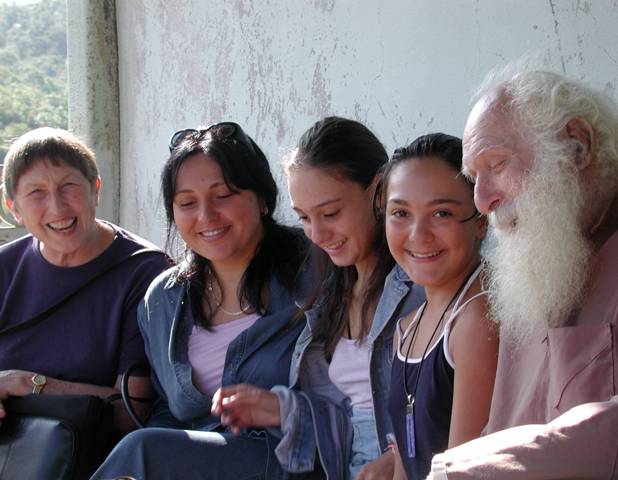
January: Letter from Tbilisi:
Before coming to Georgia to teach American art and
architecture plus museum studies at three universities, and
lectures on Chinese art, American art, American architecture
and museum management at two national Georgian museums and
to Georgian architects, I was ready for a short vacation. We
decided on Istanbul and Cappadokia, Turkey.
Istanbul is the end of the silk road which starts in China,
crosses Tbilisi, Georgia and terminates in Turkey’s meeting
place for Asia and Europe. Divided by the Bosphorus River
which joins the Black and the Marmara Sea, Istanbul has been
an important crossroad for trade all through history and
many nations fought to control it. We sail the Bosphorus and
marvel at the grand palaces on each side built by the
conquerors and rich traders. We walk through the vast, open
spaces of the Blue Mosque and Hagia Sophia, two of the
architectural marvels of the ancient world, on our tourist
days; walk the narrow streets on our people days; and relax
beside the outdoor pool on our crash days. I came to see one
building which has fascinated me most of my life. Hagia
Sophia cups out space so that the wall, which traditionally
holds up a roof, is not needed and the magnificent dome
seems to float above the viewer. For years I taught about
the importance of Hagia Sophia to the history of
architecture, getting rid of the wall for support so that
the age of Gothic cathedrals and modern skyscrapers was
possible. What no slide or internet connection can tell you
is the vast space and how small you feel in its interior.
Just down from Hagia Sophia is the spice market. One has not
shopped until you go to a large Turkish market where all the
world’s goods are hustled to all comers. You feel
claustrophobic as the street is jammed with the humanity of
many races and colors.
We flew Turkish Airlines to Ankara, the capitol of Turkey,
and then took a five-hour bus ride to Cappadokia. I had
researched St. Nino studying there in the 4th
century before she brought Christianity to Georgia and been
reading the poetry of al-Rumi for the last nine years (this
was his birthplace). As soon as our bus crested the last
hill over Goreme, a town in the center of Cappadokia, with
the mountains towering over the scene in the distance,
wonderland appeared. I was ready for many things but no
information can relate this special, magical place. As story
goes, this was a sea between Asia and Europe. In some
distant past, the earth shifted so that the bottom of the
sea rose bringing soft and hard rocks into the air and wind.
Through the centuries, the hard rock stayed on top of the
soft, making cone-like “fairy castles”. It was only in the
18th and 19th centuries that Europeans
were told of this special place on earth. Coleman Burkes,
who translated al-Rumi’s poetry, tried to order bottle water
one night here and instead ordered “the secret of the
universe”. He may not have really made a translation
mistake.
Our first night after resting at the Ottoman House, we
attended belly dancing and singing in the Yasur Baba
Restaurant, carved into a gigantic rock. As the food,
drinking and singing progressed, the communal dancing moved
outdoors around a bonfire to the hypnotic sounds of drum and
flute. I thought, “This is what the United Nations should
be- all the nations of the world dancing together.” Another
night we attended the “whirling dervishes” choreographed by
the 12th century mystical Calaladdin al-Rumi (who
the Turks call Mevlana) where the dancers spin with the
right hand pointed to heaven to receive God’s word and their
left hand toward the earth. The idea is to turn around your
heart. In the afternoons, we visited the pottery works of
Cappadokia, where they make the famous “half moon plates”,
and walked through the “king’s palace”, homes of ordinary
people and other structures carved from the soft rock. In
one house (which the New York Times mistakenly calls “a
cave” but is a home built by people), which was owned by one
extended family for 900 years, we met the great (followed by
many more greats) grandson of the original owner. The
Turkish government is making Cappadokia (Kappadokia) a
national park therefore his family has to stop living there
but he is still allowed to give tours. We sat in a small
womb-like room, where the wash place was dug from one wall
and covered with a fine Turkish rug, looked out a large
carved window and marveled at the ingenuity of mankind.
Later that night, sipping Turkish coffee in the shop of
Omar, the Turkish rug merchant who also owns the hotel where
we stayed and the tourist service we used, I learned some of
the stories about these resourceful people. Many of their
tales are the legends that grace the patterns in Turkish
rugs. Each morning at sunrise this cultured man of peace
walks among the fairy castles of Cappadokia. It was with
envy that I left Omar and nature’s wonderland.
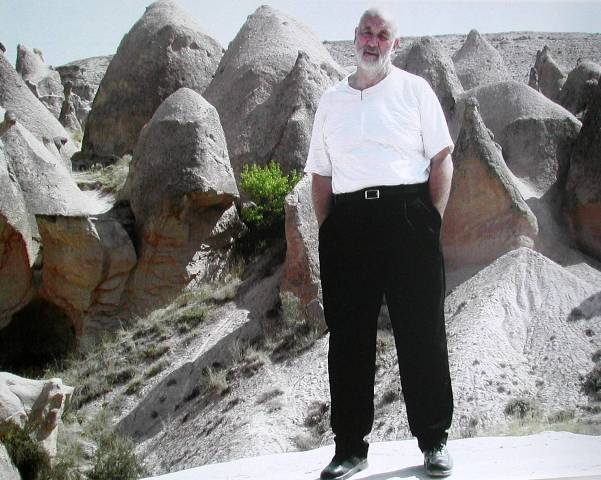
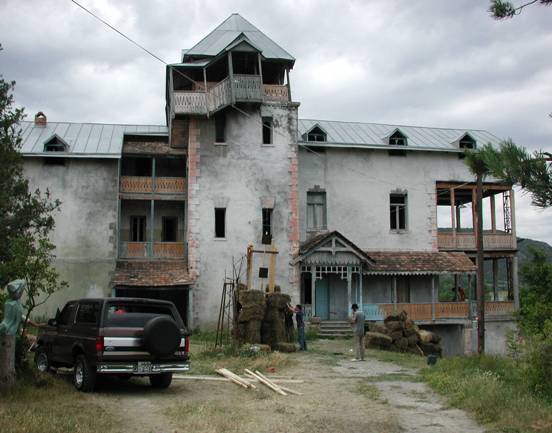
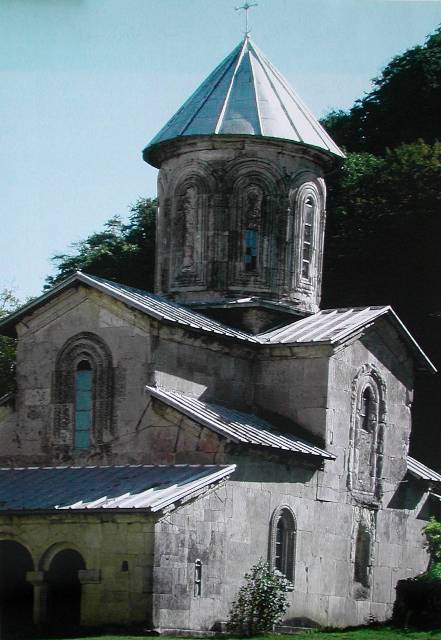
|

